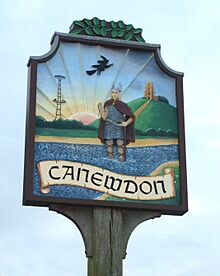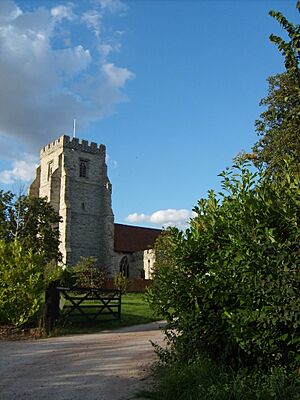Canewdon facts for kids
Quick facts for kids Canewdon |
|
|---|---|
 Canewdon village sign, showing a witch, the church, a Viking, and the former radar tower |
|
| Population | 1,072 (2011) |
| OS grid reference | TQ900945 |
| Civil parish |
|
| District |
|
| Shire county | |
| Region | |
| Country | England |
| Sovereign state | United Kingdom |
| Post town | ROCHFORD |
| Postcode district | SS4 |
| Dialling code | 01702 |
| Police | Essex |
| Fire | Essex |
| Ambulance | East of England |
| EU Parliament | East of England |
| UK Parliament |
|
Canewdon is a village and civil parish in the Rochford area of Essex, England. It's about 4 miles (6.4 km) northeast of the town of Rochford. The village stretches for several miles along the southern side of the River Crouch.
Canewdon sits on one of the highest hills along the Essex coast. From here, St Nicholas's Church offers amazing views of the Crouch river mouth. To the east of the village is Wallasea Island, which is popular for sailing and is a special place for wildlife.
The name Canewdon comes from old English words meaning 'the hill of Cana's people'. Some people mistakenly think it's named after King Canute. He fought and won the Battle of Ashingdon nearby in 1016 against the English King Edmund Ironside.
Contents
Canewdon's Past: A Look at History
Early History of Canewdon
People have lived in and around Canewdon for a very long time. We know this from things found in the area, dating back to the Neolithic period (4,000–2,000 BC). For example, when people were digging for gravel in the early 1900s, they found ancient items. These included a collection of Neolithic axes and tools from the Iron Age. You can even see a Bronze Age paddle from Canewdon at the National Maritime Museum in Greenwich.
Canewdon was a good place to live because it was high up, offering great views. It was also close to the sea, which was good for trading and making salt. From prehistoric times and during the Roman period, farms and burial sites were built on higher ground. Roman pots were discovered in the village in 1712. Along the coast, people found Roman 'Red Hill' salterns. These were structures with clay floors heated by flues, used for making salt. Salt was important for food, for animals, and even in making metals and dyes.
Medieval Times in Canewdon
The name Canewdon is much older than the Danish King Canute, by about 400 years. However, it's believed that this area was the site of an old camp used by King Canute. He might have stayed here during the Battle of Assandun (also known as Ashingdon) in 1016. This battle was part of his successful invasion of Essex. Some old earthworks between the village and the river are thought to be what's left of Canute's camp.
The name Canewdon comes from the Saxon words for 'hill of Cana's people'. It was first written down in the Domesday Book in 1086 as Carenduna. At that time, there were 28 households in the village. Swein of Essex was the main landowner in the Rochford area. Canewdon Hall, a strong house that was central to the village in medieval times, was pulled down in 1966. A new housing area, Canewdon Hall Close, was built where it once stood.
Modern Canewdon History
In the late 1800s, the local jobs in coastal industries, farming, and brick-making started to decrease. Because of this, the number of people living in Canewdon changed a lot. In 1801, there were 569 people. This grew to 723 in 1841 but then dropped to 495 by 1901.
During the First World War, in 1915, a woman named Agnes Frances Whitwell, who was from Canewdon, was sadly killed. A bomb dropped by a Zeppelin (a type of airship) hit her home in Southend-on-Sea.
Before the Second World War, in 1937, the Royal Air Force (RAF) set up a special radar site in Canewdon. This was one of four sites testing a new system called Chain Home. This system used radar to find enemy aircraft and figure out how far away they were. The final twenty Chain Home sites were very important for defending against German planes during the war. Information from these radar sites and observation posts was sent through underground telephone lines to a central room. Here, experts would analyze the data and send out warnings.
The Chain Home radar tower from Canewdon was moved in 1956 to Great Baddow, where you can still see it today. The underground bunkers that protected the radar equipment are still in Canewdon.
In the later part of the 1900s, more homes were built in Canewdon. This included a new housing area built in the 1960s. The 2001 census showed that Canewdon had 588 homes and a population of 1,477 people.
St Nicholas's Church
The Parish Church of St Nicholas was built in the 1300s. It stands at the end of the village High Street, on a ridge overlooking the River Crouch. Its tall tower, built in the 1400s, is very impressive and can be seen from many miles away. People say that King Henry V had the tower built after his big victory at the Battle of Agincourt in France.
During the time of Queen Elizabeth I, the tower was used as a landmark to help ships navigate along the River Crouch. In the First World War, the tower was used as a lookout and for sending signals. Near the church, you can still see the old village lock-up (a small jail) and stocks (a device used for public punishment).
The church is a Grade II* listed building, which means it's a very important historic building.
Legends of Witchcraft and Ghosts
Canewdon is famous for its legends of witchcraft and ghosts. George Pickingill (1816–1909), who lived in the village in the late 1800s, was known as a "cunning man." This meant he was believed to have special knowledge or powers, often used for healing or finding lost things.
One of the earliest written stories about witchcraft in Canewdon is about Rose Pye. In 1580, she was accused of being a witch and of causing the death of a 12-month-old child named Johanna Snowe in 1575. Rose said she was not guilty in court and was found innocent. However, she sadly died in jail a few months later. Five years after that, another woman named Cicely Makin was accused of witchcraft. She couldn't find five people to say she wasn't a witch. After being given five years to change her ways, she was removed from the church.
Author Ian Yearsley has written a book based on the witchcraft legends in the village. It's called The Curse of Cannow's End (published in 2012). 'Cannow's End' is a mixed-up version of 'Canewdon'. There's also a second book, Return to Cannow's End (2017).
The British TV show Most Haunted Live visited Canewdon in 2004 as part of their Easter special. They explored the village on Good Friday, April 9, 2004, looking for paranormal activity.
See also
 In Spanish: Canewdon para niños
In Spanish: Canewdon para niños



